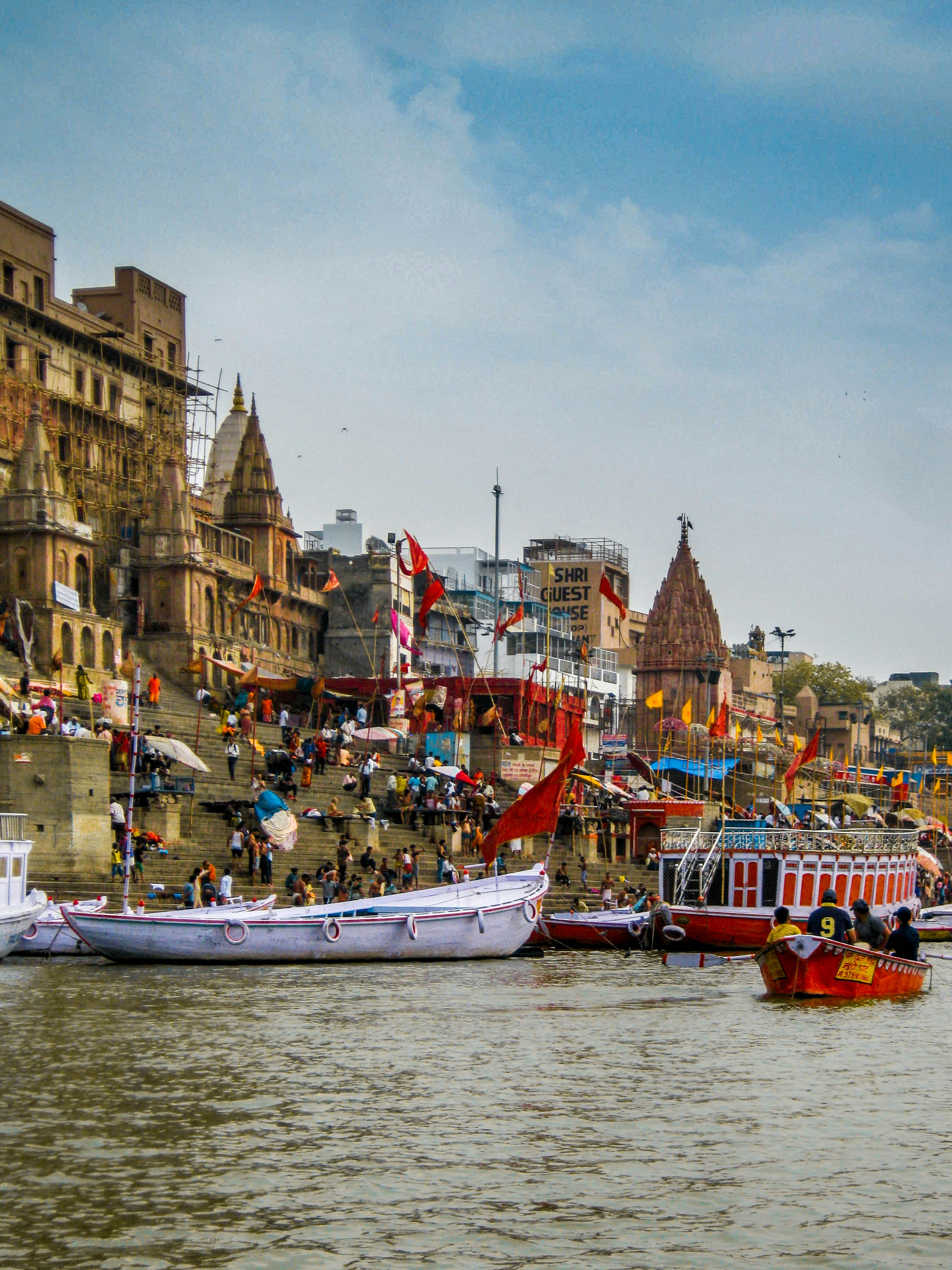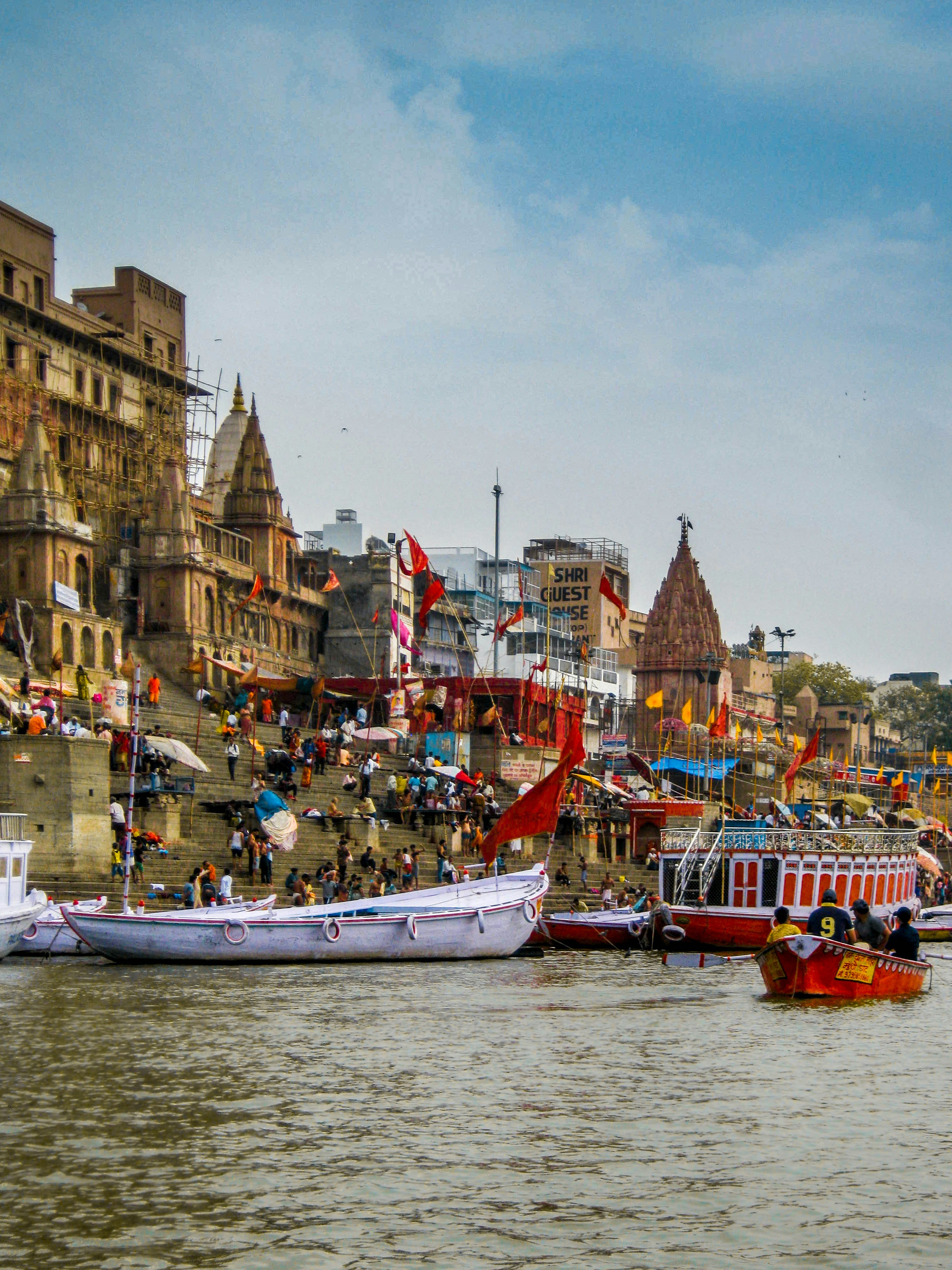Visiting Varanasi is like stepping into a time capsule, where ancient traditions and customs are still alive and thriving. The city is home to numerous temples, ghats, and ashrams, each with its own unique history and significance. The Kashi Vishwanath Temple, dedicated to Lord Shiva, is one of the most revered temples in Varanasi and is believed to be one of the twelve Jyotirlingas, the holiest Shiva temples in the country.
One of the highlights of a trip to Varanasi is witnessing the Ganga Aarti, a mesmerizing and spiritual ceremony that takes place every evening on the banks of the River Ganges. The ghats, or steps leading down to the river, come alive with the sound of chanting, the fragrance of incense, and the flickering flames of the aarti lamps. Devotees and tourists gather to witness this sacred ritual, offering prayers and floating diyas (small oil lamps) on the river, creating a breathtaking sight.
Aside from its religious significance, Varanasi is also a hub of art, music, and literature. The city has produced renowned poets, writers, and musicians who have contributed immensely to the cultural heritage of India. The Banaras Hindu University, one of the largest residential universities in Asia, is located in Varanasi and is known for its courses in arts, sciences, and humanities.
Exploring the narrow lanes of Varanasi is an adventure in itself. The bustling markets are filled with vibrant textiles, intricate handicrafts, and mouth-watering street food. The famous Banarasi sarees, known for their exquisite silk and intricate weaving patterns, are a must-buy for anyone visiting the city. The aroma of freshly brewed chai (tea) and the sizzle of hot jalebis (sweet pretzels) fill the air, tempting visitors to indulge in the local culinary delights.
Varanasi is also a center for yoga and spirituality, attracting seekers from all over the world. The city offers a serene and peaceful environment for meditation and self-reflection. Many ashrams and yoga centers provide classes and retreats for those looking to deepen their spiritual practice.
As the sun sets over the Ganges, casting a golden glow on the ancient city, the soul of Varanasi comes alive. It is a place where time seems to stand still, where traditions are passed down through generations, and where the past and present merge seamlessly. Varanasi is not just a destination; it is an experience that leaves an indelible mark on the hearts and minds of those who visit.
As you explore the ghats of Varanasi, you will come across the Assi Ghat, located at the confluence of the Ganges and the Assi rivers. This ghat holds great significance in Hindu mythology, as it is believed to be the place where Lord Shiva, the supreme deity, resides. Devotees flock to Assi Ghat to take a holy dip in the sacred waters, seeking spiritual purification and blessings.
One of the oldest and most revered ghats in Varanasi is the Harishchandra Ghat. It is named after King Harishchandra, known for his unwavering commitment to truth and righteousness. According to ancient legends, King Harishchandra worked as a cremator at this ghat, sacrificing his kingdom, family, and even his own self-respect to uphold his integrity. The Harishchandra Ghat serves as a reminder of the importance of honesty and integrity in one’s spiritual journey.
Varanasi is not just a city of ghats; it is also a hub of spirituality and learning. The city is home to numerous temples, ashrams, and educational institutions, attracting scholars, seekers, and spiritual enthusiasts from all over the world. The famous Kashi Vishwanath Temple, dedicated to Lord Shiva, is a major pilgrimage site, believed to grant liberation from the cycle of life and death.
For those seeking spiritual knowledge and enlightenment, Varanasi offers a wealth of opportunities. The city is renowned for its ancient centers of learning, known as “gurukuls” and “ashrams.” Here, students immerse themselves in the study of ancient scriptures, philosophy, and meditation under the guidance of revered spiritual masters. The serene and peaceful atmosphere of these ashrams provides the perfect setting for introspection and self-discovery.
Varanasi is not just a physical place; it is a spiritual realm where the boundaries between the material and the divine blur. The city’s rich tapestry of rituals, beliefs, and traditions creates an atmosphere that is both mystical and enchanting. Whether you are a devout pilgrim seeking spiritual solace or a curious traveler in search of a deeper understanding of life, Varanasi offers an experience that is truly transformative.
Aside from its temples and silk weaving industry, Varanasi is also known for its rich music and dance traditions. The city has been a hub for classical music and dance for centuries, attracting renowned artists from all over the country.
One of the most prominent forms of classical music in Varanasi is Hindustani classical music. The city has produced many legendary musicians who have contributed to the development and preservation of this art form. The famous gharanas (schools) of Varanasi, such as the Benaras gharana and the Senia gharana, have nurtured and produced some of the finest musicians in the country.
Similarly, Varanasi is also known for its vibrant dance traditions, with Kathak being one of the most popular dance forms in the city. Kathak, which originated in the temples of North India, is a storytelling dance form that combines graceful movements, intricate footwork, and expressive facial expressions. The city is home to several renowned Kathak dancers and dance schools, where students from all over the world come to learn and train.
Exploring the cultural heritage of Varanasi is not complete without experiencing its vibrant festivals. The city is known for its grand celebrations of festivals like Diwali, Holi, and Durga Puja. During these festivals, the streets come alive with colorful processions, music, dance, and elaborate decorations. Witnessing these festivities is a sensory overload, immersing visitors in the rich cultural tapestry of the city.
Furthermore, Varanasi is also a center for spiritual and philosophical learning. The city has been a hub for scholars, philosophers, and seekers of knowledge for centuries. The famous Banaras Hindu University, established in 1916, is one of the oldest and most prestigious educational institutions in India. The university offers courses in various disciplines, including arts, sciences, medicine, and philosophy, attracting students from all over the world.
Varanasi’s cultural heritage is not just confined to its temples and markets; it is a living, breathing tapestry that encompasses music, dance, festivals, and intellectual pursuits. Exploring this vibrant city is a journey into the heart and soul of India’s rich cultural heritage.
Aside from these popular dishes, Varanasi is also known for its rich and diverse street food culture. Walking through the narrow lanes of the city, you will come across numerous food stalls and carts offering a wide array of snacks and sweets.
One such snack is the famous Tamatar Chaat. Made from ripe tomatoes, this tangy and spicy dish is a favorite among locals and tourists alike. The tomatoes are roasted on an open flame and then mashed with a blend of spices, chutneys, and crispy sev, creating a burst of flavors in every bite.
Another street food delicacy that shouldn’t be missed is the Baati Chokha. Baati, a round bread made from wheat flour, is traditionally baked in a clay oven and served with a spicy potato curry called chokha. The combination of the smoky baati and the flavorful chokha is a match made in culinary heaven.
If you’re in the mood for something refreshing, try the famous Lassi of Varanasi. This traditional yogurt-based drink is often flavored with rose syrup, saffron, or mango pulp, and garnished with dry fruits. It is a perfect way to beat the heat and quench your thirst while exploring the city.
Varanasi is also known for its unique breakfast options. One such dish is the Malai Toast, a crispy bread topped with a thick layer of malai (clotted cream) and sprinkled with sugar. This indulgent treat is a favorite among locals and is often enjoyed with a cup of piping hot chai.
As you explore the culinary delights of Varanasi, don’t forget to try the local specialty, the Banarasi Paan.
Whether you’re a food lover or simply looking to explore the local flavors, Varanasi has something to offer for everyone. From street food to traditional sweets, the city’s culinary scene is a treasure trove waiting to be discovered.
Preserving the Heritage
While Varanasi’s cultural heritage is undoubtedly captivating, it is essential to ensure its preservation for future generations. The city faces various challenges such as pollution, overcrowding, and encroachment, which threaten its heritage sites and cultural practices.
Efforts are being made by the government and various organizations to conserve and restore the heritage of Varanasi. Strict regulations are in place to protect the ghats and heritage buildings from encroachment and illegal construction. Awareness campaigns are also conducted to educate the locals and tourists about the importance of preserving the city’s cultural legacy.
Visitors to Varanasi can contribute to the preservation of its heritage by being responsible travelers. Respecting the religious practices, following the guidelines at the ghats, and refraining from littering are simple yet impactful ways to ensure the sustainability of Varanasi’s cultural capital.
In addition to these efforts, there are ongoing initiatives to restore and maintain the ancient temples, palaces, and other architectural marvels that dot the cityscape. Skilled artisans and craftsmen work tirelessly to repair the intricate carvings, frescoes, and sculptures that adorn these structures. This not only helps in preserving the physical aspects of Varanasi’s heritage but also provides employment opportunities for the local community.
Furthermore, cultural festivals and events are organized throughout the year to celebrate and showcase the rich traditions of Varanasi. These events not only attract tourists but also serve as a platform for local artists, musicians, and performers to showcase their talent. By attending and supporting these events, visitors can contribute to the preservation of Varanasi’s cultural heritage.
Another aspect of heritage preservation in Varanasi is the documentation and digitization of historical records, manuscripts, and artworks. This ensures that valuable information and artifacts are preserved in a digital format, making them accessible to researchers, scholars, and enthusiasts from around the world. This digitization process also helps in creating a comprehensive database of Varanasi’s cultural heritage, aiding in its conservation and research.
Preserving the intangible cultural heritage of Varanasi is equally important. Traditional music, dance forms, rituals, and oral traditions are passed down through generations, contributing to the city’s unique cultural identity. Efforts are being made to document and promote these intangible cultural practices, ensuring that they are safeguarded and continue to thrive.
In conclusion, the preservation of Varanasi’s heritage requires a multi-faceted approach that involves government intervention, community participation, and responsible tourism. By combining efforts to protect the physical structures, promote cultural events, digitize historical records, and safeguard intangible cultural practices, Varanasi can continue to be a living testament to its rich cultural heritage for generations to come.
Enter your email to get the Latest Updated Exploring News and Topics
Discover more from atozexplore.com
Subscribe to get the latest posts sent to your email.







